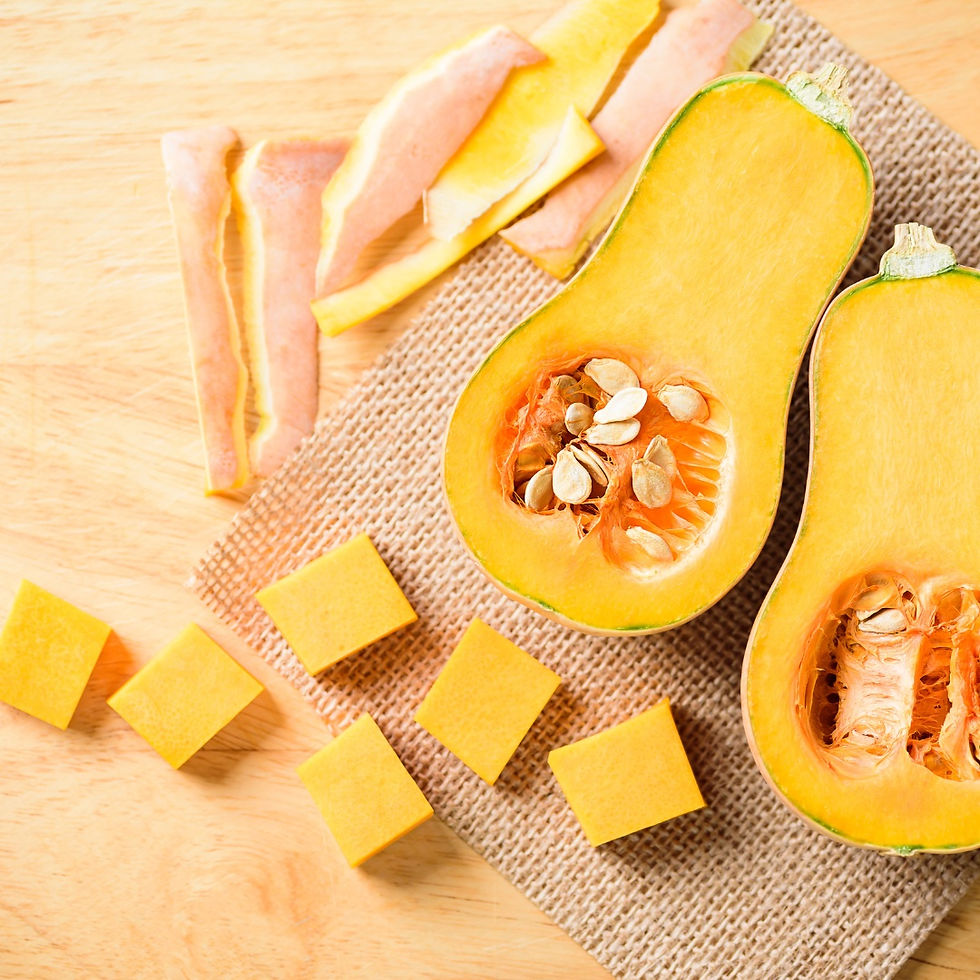GET YOUR VITAMIN A WITH BUTTERNUT SQUASH
- marlenemedina66
- Jan 7, 2024
- 3 min read

Packed With Vitamins and Minerals
Butternut squash is an excellent source of many vitamins and minerals.
A one-cup (205-gram) serving of cooked butternut squash provides more than 450% of the RDI for vitamin A and over 50% of the RDI for vitamin C.
It’s also rich in carotenoids — including beta-carotene, beta-cryptoxanthin, and alpha-carotene — plant pigments that give butternut squash its bright color.
These compounds are provitamin A carotenoids, meaning your body converts them into retinal and retinoic acid — the active forms of vitamin A
Vitamin A regulates cell growth, eye health, bone health, and immune function.
Additionally, it’s vital for fetal growth and development, making it an essential vitamin for mothers-to-be.
Butternut squash is also rich in vitamin C — a water-soluble nutrient for immune function, collagen synthesis, wound healing, and tissue repair.
Both vitamins A and C work as potent antioxidants in your body, protecting your cells from damage caused by unstable molecules called free radicals.
Vitamin E is another antioxidant in butternut squash that helps protect against free radical damage and may reduce your risk of age-related conditions, such as Alzheimer’s disease.
This winter squash is also packed with B vitamins — including folate and B6 — which your body needs for energy and red blood cell formation.
Moreover, it’s high in magnesium, potassium, and manganese — all of which play essential roles in bone health.
For example, manganese is a co-factor in bone mineralization, building bone tissue.
Tips for Handling Butternut Squash:
Peeling Made Easy: To make peeling easier, microwave the whole squash for a few minutes to soften the skin slightly. Use a vegetable peeler or a sharp knife to remove the skin.
Seed Harvesting: Don't discard the seeds! Roast them for a tasty snack. Clean them, toss them with olive oil and spices, and bake until golden brown.
Cubing Techniques: Cut off the top and bottom of the squash into cubes. Cut the neck from the bulbous base, making it easier to cube. Scoop out the seeds with a spoon before peeling and cutting for the bulb.
Benefits of Butternut Squash:
Nutrient-Rich: Butternut squash is a good source of vitamins A and C, potassium, and fiber. These nutrients contribute to overall health, supporting immune function and promoting digestive health.
Antioxidant Properties: The high levels of antioxidants, particularly beta-carotene in butternut squash, help combat oxidative stress and inflammation in the body.
Heart Health: Potassium and fiber in butternut squash support heart health by regulating blood pressure and cholesterol levels.
Weight Management: The fiber content in butternut squash promotes satiety, making it a great addition to meals for those looking to manage their weight.
Butternut Squash Recipes:
Roasted Butternut Squash:
Peel and cube the squash.
Toss with olive oil, salt, pepper, and your favorite herbs.
Roast in the oven until caramelized and tender.
Butternut Squash Soup:
Sauté onions and garlic in a pot.
Add cubed butternut squash, broth, and seasonings.
Simmer until squash is soft, then blend until smooth.
Butternut Squash Risotto:
Sauté diced butternut squash with onions.
Add Arborio rice and cook until translucent.
Gradually add vegetable broth, stirring until absorbed.
Finish with Parmesan cheese and fresh herbs.
Stuffed Butternut Squash:
Cut the squash in half and scoop out the seeds.
Roast until almost tender.
Fill with a mixture of quinoa, vegetables, and herbs.
Bake until the filling is cooked through.
Incorporating butternut squash into your diet provides not only a burst of flavor but also a myriad of health benefits. Experiment with these recipes and enjoy the versatility of this nutritious and delicious vegetable.







Comments